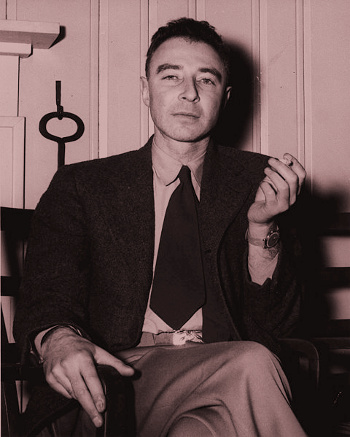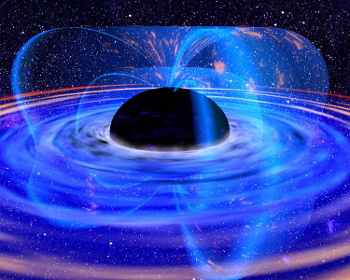J. Robert Oppenheimer and Black Holes
April 24, 2017
Most
languages allow the construction of
compound words; so, in
English, we have words such as
backpack,
searchlight, and
railroad. The
German language seems to take this concept to excess, building extremely long words.
Mark Twain wrote in his
essay, "
The Awful German Language," published as an
appendix to the second volume of "
A Tramp Abroad," that "Some German words are so long that they have
perspective".[1]
A few of the smaller compound German words are in common use among English speakers. The prime example of this is "
schadenfreude," the enjoyment attained from seeing someone else's misfortune. The word even appeared in an episode (Episode 3,
Season 3, "
When Flanders Failed") of
The Simpsons. In that episode,
Lisa Simpson defines the word for
Homer Simpson, who is reveling in the misfortune of his neighbor,
Ned Flanders.[2]
I've never had occasion to use the word, schadenfreude.
Scientists are
good-natured people who share
information and want their
competitor's experiments to succeed. I'm sure that there were cheers at
Fermilab when the the
Higgs boson was discovered in 2012 at
CERN, but no cheers when the
Large Hadron Collider exploded in 2008. One compound German word that I enjoy using is
putzfimmel, the word for
cleaning mania. I don't like
vacuum cleaner noise. To write a
blog like this, you need "
sprachgefühl," a "feeling for language."

Putzfimmel
An illustration by Charles Keene (1823–1891), from a book by Douglas William Jerrold, "Mrs Caudle's curtain lectures," page 193.
This was a comic strip originally published in Punch magazine.
(Modified Wikimedia Commons image.)
Physicist,
Freeman Dyson, has used the German word, "
sitzfleisch," to describe
American physicist,
J. Robert Oppenheimer (1904-1967).[3] Sitzfleisch is the ability to sit still and work quietly. As I write this I'm reminded of
Daya's song, "
Sit Still, Look Pretty."[4] In a lengthy article in 2013 in the
New York Review of Books, Dyson writes that Oppenheimer was not able to sit long enough to finish a difficult
calculation. As a consequence, his calculations contained many
errors.
This lack of sitzfleisch extended to Oppenheimer's
seminars, in which he would be in
constant motion, incessantly
smoking.[3] Dyson also writes about Oppenheimer's "
pathological" interest in everything, a
personality trait that he shared with
Richard Feynman, who decided he needed to know why a
thrown dinner plate wobbled the way that it did.[5] Dyson comments that Oppenheimer's personality traits prevented his becoming a great scientist, and the only significant problem that he solved was the
gravitational collapse of
massive stars into
black holes.[3]
With the
discovery at
LIGO of
gravitational waves arising from the
merger of black holes, black holes are very much in the news. Three
papers from 1938-1939, co-authored by Oppenheimer, discuss the existence of black holes.[6-8] Dyson writes that Oppenheimer's papers on black holes were his "only revolutionary contribution to science."[3] Interestingly, Oppenheimer didn't think the work was significant, and he placed the most importance on his early
research on the
positron.

J. Robert Oppenheimer, smoking a cigarette, at the Guest Lodge, Oak Ridge, February 1946.
This was nearly twenty years before the 1964 Surgeon General report on smoking. Oppenheimer died from throat cancer on February 18, 1967, at the young age of 62.
(DOE Digital Archive Image 2017659, photograph by Ed Westcott, via Wikimedia Commons, modified for artistic effect.)
The starting point for a black hole is a
neutron star. Oppenheimer and post-doc
Robert Serber published the paper, "On the stability of stellar neutron cores,"in 1938.[6] The next year, Oppenheimer and his
graduate student,
George Volkoff, published the paper, "On Massive Neutron Cores," in which they
calculated the mass above which a star should collapse into a neutron star.[7] All this was long before neutron stars
were detected in 1967.
Oppenheimer and
Hartland Snyder, another of his students, published the 1939 paper, "On Continued Gravitational Attraction", that predicted the existence of black holes; or, as they wrote, objects for which "an observer co-moving with the
matter would not be able to send a
light signal from the star; the
cone within which a signal can escape has closed entirely."[8] It wasn't until 1967 that
John Archibald Wheeler (1911-2008) coined the term, "black hole."
Oppenheimer and Snyder found that static solutions of stellar collapse were impossible, but solutions where the object continued to change in
time were allowed; that is, the object would continually contract.[8-9] Finally, "The star thus tends to close itself off from any
communication with a distant observer; only its
gravitational field persists."[8-9]
Most physicists thought that nature would not allow such
infinite collapse.
Russian physicist and eventual
Nobel Laureate,
Lev Landau, thought that something in
quantum mechanics would disallow such a thing.[9] The paper, and the idea of the black hole was essentially ignored until Wheeler and other physicists revived the concept
decades later.[9]
A team of physicists from the
School of Physics of the
University of Costa Rica (San José, Costa Rica) have just published an article on
arXiv examining a few
historical aspects of Oppenheimer's black hole paper, including its neglect by both Oppenheimer and the physics community.[10] They undertake to answer the following questions:
• Whether the Oppenheimer paper was considered good science according to the standards of the time.
• Whether the work was ignored because Oppenheimer was not preeminent among scientists in the field.
They conclude that the paper was good science, and that Oppenheimer had a good standing in physics. It was just an
idea before its time.[10]

The hole may be black, but its surrounding accretion disk is anything but.
(NASA image, via Wikimedia Commons.)
![]()
References:
- Mark Twain, The Awful German Language (A Tramp Abroad, Appendix D), via wikisource.
- The Simpsons - Schadenfreude, YouTube Video, January 10, 2016. For an example in a German language YouTube video by SimpsonsGagsGermany, view this (May 11, 2015).
- Freeman Dyson, "Oppenheimer: The Shape of Genius," The New York Review of Books, August 15, 2013. (Preview available, but subscription required for the complete article).
- Daya - Sit Still, Look Pretty, YouTube VEVO video, September 9, 2016.
- S. M. Blinder, "Feynman's Wobbling Plate," wolfram.com.
- J. R. Oppenheimer and Robert Serber, "On the stability of stellar neutron cores," Physical Review, vol. 54, no. 7 (October 1, 1938), p. 540, DOI:https://doi.org/10.1103/PhysRev.54.540.
- J. R. Oppenheimer and G. M. Volkoff, "On Massive Neutron Cores," Physical Review, vol. 55, no. 4 (February 15, 1939), pp. 374-38, DOI:https://doi.org/10.1103/PhysRev.55.374.
- J. R. Oppenheimer and H. Snyder, "On continued gravitational contraction," Physical Review, vol. 56, no. 5 (September 1, 1939), pp. 455-459, DOI:https://doi.org/10.1103/PhysRev.56.455.
- David Lindley, "Focus: Landmarks—Forgotten Black Hole Birth," Physics, vol. 13, no. 23, May 28, 2004.
- Manuel Ortega-Rodríguez, Hugo Solís-Sánchez, Eduardo Boza-Oviedo, Kenneth Chaves-Cruz, Milena Guevara-Bertsch, Marianela Quirós-Rojas, Sofía Vargas-Hernández, and Ariadna Venegas-Li, "The Early Scientific Contributions of J. Robert Oppenheimer: Why Did the Scientific Community Miss the Black Hole Opportunity?" arXiv, March 13, 2017.
Permanent Link to this article
Linked Keywords: Language; compound word; English language; backpack; searchlight; railroad; German language; Mark Twain; essay; The Awful German Language; addendum; appendix; A Tramp Abroad; perspective; schadenfreude; The Simpsons; Season 3; When Flanders Failed; Lisa Simpson; Homer Simpson; Ned Flanders; scientist; good-natured; information; competition; competitor; experiment; Fermilab; Higgs boson; CERN; Large Hadron Collider; quench incident; exploded; putzfimmel; cleaning; mania; vacuum cleaner; blog; sprachgefühl; Charles Keene (1823–1891); Douglas William Jerrold; comic strip; Punch magazine; Wikimedia Commons; physicist; Freeman Dyson; sitzfleisch; American; J. Robert Oppenheimer (1904-1967); Daya; Sit Still, Look Pretty; New York Review of Books; calculation; error; seminar; fidgeting; constant motion; smoking; psychopathology; pathological; personality trait; Richard Feynman; throwing; thrown; dinner plate; wobble; gravitational collapse; massive star; black hole; first observation of gravitational waves; LIGO; binary black hole; merger of black holes; scientific literature; paper; research; positron; smoking; cigarette; Smoking and Health: Report of the Advisory Committee to the Surgeon General of the United States; 1964 Surgeon General report on smoking; throat cancer; neutron star; Robert Serber; postgraduate education; graduate student; George Volkoff; Tolman-Oppenheimer-Volkoff limit; mass; PSR B1919+21; Hartland Snyder; matter; light; signal; light cone; John Archibald Wheeler (1911-2008); time; communication; gravitational field; infinity; infinite; Russia; Russian; Nobel laureate in Physics; Lev Landau; quantum mechanics; decade; School of Physics; University of Costa Rica (San José, Costa Rica); arXiv; history; historical; idea; accretion disk.